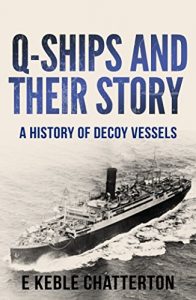During the First World War, Britain relied heavily on resources imported across the Atlantic by its merchant marine.
From the very beginning of the war, German U-boats targeted the merchant convoys, sinking millions of tons of essential produce and threatening Britain’s war effort.
Were it not for the heroic efforts of the Q-ships, the naval war could have proven disastrous for the allies.
Between 1914 and 1918, nearly 200 commercial vessels were transformed into armed decoy ships that lured U-boats into attacking them at close range before responding with their own deadly fire at the very last moment.
From tramp steamers to sailing ships, from fishing boats to tugs, every type of ship was used in this great act of deception.
The demands on the crews of these ships were immense – requiring supreme bravery, exceptional patience, a high degree of cunning and excellent seamanship.
In this book, E. Keble Chatterton takes us through the story of these ships in an entertaining narrative, highlighting one of the lesser known aspects of World War One.
Writing with narrative flair and a passion for the subject, Chatterton places the reader in the middle of the tense war for the Atlantic.
Edward Keble Chatterton (1878-1944) was a sailor and prolific writer from Sheffield. His voyages across the English Channel, to the Netherlands, around the Mediterranean and through the French canals led to many articles and books. Joining the R.N.V.R. at the outbreak of WWI he commanded a motor launch flotilla, leaving the service in 1919 as a Lieutenant Commander. Between the wars his output included works about model ships, juvenile novels, and narrative histories of naval events; from 1939, his writing focused upon WWII.






